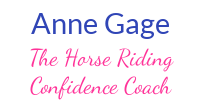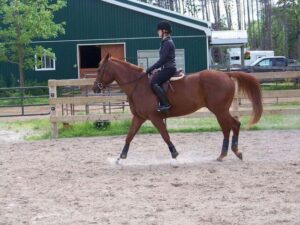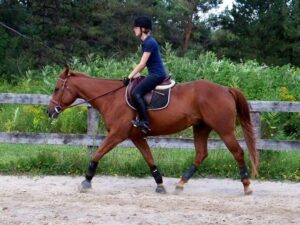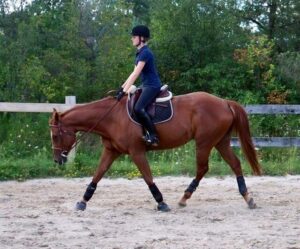A student asked me if it was okay that her horse was putting her head down while being ridden. This particular little mare is one of the more popular school horses at a busy riding school.
As is the fate of nice, easy going lesson horses, she carries around a lot of beginner riders.
The young riders (and their parents) are eager to do the fun stuff like cantering and jumping. As a result, basics are skipped and there is a lot of bouncing on the horses’ backs, pulling and balancing on the reins and kicking to get the horses to go.
There is often very little focus on the horse’s frame and these ‘up-down’ beginner lesson horses frequently have poor, unhealthy postures accompanied with muscle soreness.
Poor riding skills and posture cause tension, imbalance, and poor posture in the horse.
And poor posture in the horse makes it challenging for the rider to maintain a good riding position.
What Is Good Posture?
In a healthy posture, the muscles are more developed along the top of the neck, the back and the haunches. These muscles are sometimes referred to as the "topline".
To develop these topline and hindquarter muscles correctly, the horse needs to engage both the hindquarters and the core muscles.
With the hindquarters engaged and driving the movement, the forehand is lifted and the horse feels light in the rider’s hands.
Developing this healthy, ’round’ posture (or 'frame') in the horse requires suppleness, balance and lightness from the rider.
How Riders Create Poor Posture In Horses
It’s really hard for a horse to carry herself in a correct, healthy frame/posture – which requires lifting her back and stepping well underneath herself – if the rider is pulling on her mouth and jamming down on her back bouncing up and down trying to stay balanced.
It’s also challenging for the rider to learn and maintain a good riding position on a horse with that poor posture.
The horse copes by dropping her back, pulling with her frontend (rather than driving from the hindquarters) and either carrying her head high or pulling down on the reins.
This posture makes the muscles along the top of the neck, the back and the hindquarters weak and under developed.
But the muscles on the underside of the neck become more developed creating a ‘ewe’ neck.
Because the core muscles and the back muscles weak, the horse's back drops and she may look like she has a big, ‘hay’ belly. This big belly is the result of weak back muscles being unable to support the weight of the abdomen - let alone that of a saddle and rider - so the belly hangs down like a hammock.
How To Improve A Horse's Posture
In the lessons with this particular student and mare, I focused on exercises that helped the rider develop an independent seat – well balanced, centred and supple – while helping the horse stretch and strengthen her back muscles and engage her core muscles (yes horses do have core muscles, too) by stepping her hind legs further under her body.
Engaging the hindquarters naturally lifts the horse's back allowing her to lengthen her stride and stretch into a long and low frame.
So, in this posture, the horse carrying her head being low is good because she is stretching the muscles on her top line while engaging her core muscles.
It’s similar to you doing a nice forward bend in yoga. It doesn’t hurt and you feel an ‘opening’ along your spine.
But, there is a difference between stretching and pulling.
As long as the horse feels light in your hands, she is stretching and working off her hindquarter.
However, if you feel like you’re holding your horse up or that you’re being pulled forward out of your saddle then your horse is falling on the forehand or pulling against you to try to get rid of the rein contact.
How to Get Your Horse Working from the Hindquarters
- Develop a good foundation in the saddle. Make sure you are balanced in the saddle and not supporting yourself with the reins. Read this article for more tips on improving your riding position.
- Ride with quiet, following hands. Keep your hands just above your horse's shoulders. Have a soft bend in your elbows and keep them just in front of the mid-line of your torso. Maintain light, following and even contact on both reins.
- Use your seat and legs to turn your horse. DO NOT pull your horse's head into the turn with your reins. Reins back up the seat and leg aids by creating boundaries that keep your correctly aligned nose to tail. (If you need more help with turning your horse, get a copy of my book, Confident Rider Confident Horse.)
- Ride balanced circles. Pay attention to your horse's bend and work with it rather than against it. If your horse is pulling, rushing or strong, do not pull back against her. Instead, riding into a balanced circle and gradually making it smaller will help to soften and slow her.
- Practice simple lateral movements. Lateral movements like leg yielding and spiraling in and out on a circle encourage your horse to bring her inside hind leg forward and underneath herself.
Watch this short video (2:12 minutes) to see how I use these techniques to bring my mare into a light and balanced frame.



